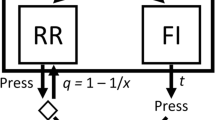Abstract
Lever responses of rats were reinforced under progressive ratio schedules where the response requirement increased after each reinforcement. The ratio could be reset to its initial value by an alternative response. Systematic relations were found between the size of the progressive ratio schedule and the frequency of the reset responses. The procedure facilitated an analysis of the interaction of effort and time variables which were reflected in the sequential properties of the responses.
Similar content being viewed by others
References
FINDLEY, J. D. 1958. Preference and switching under concurrent scheduling. J. exp. Anal. Behav., 1, 122–148.
HARZEM, P. 1968. Temporal discrimination. In S. Sutherland and R. Gilbert (Eds.) Discrimination Learning, London: Academic Press, (in press).
HODOS, W. 1961. Progressive ratio as a measure of reinforcement strength. Science, 134, 943–944.
SOLOMON, R. L. 1948. The influence of work on behavior. Psychol Bull, 45, 1–31.
Author information
Authors and Affiliations
Additional information
This research was supported in part by a NIH grant (No. 5 ROI MH12115-02) and a grant from the Medical Research Council, United Kingdom.
Rights and permissions
About this article
Cite this article
Hurwitz, H.M.B., Harzem, P. Progressive Ratio Performance with Reset Option. Psychol Rec 18, 553–558 (1968). https://doi.org/10.1007/BF03393806
Published:
Issue Date:
DOI: https://doi.org/10.1007/BF03393806




